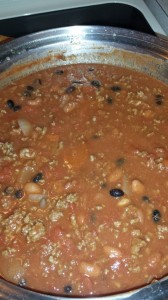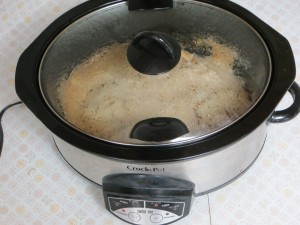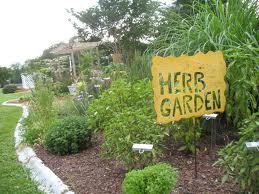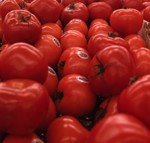by Kendra Hughson | Jan 8, 2014

Soup is a great way to pack your diet with vegetables.
Nothing tastes as good on a cold, winter day as a nice hot bowl of soup. Soups are easy to make and economical. Homemade soups are healthy. They are a great way to pack more vegetables into your diet. You can control the amount of sodium by making your own broth or white sauce or by choosing canned broth and vegetables low in sodium. Use herbs and spices for flavor instead of salt. Be creative – there are endless possible combinations of ingredients that will make a delicious soup.
Soup is easy to freeze for later use: freeze your soup in zipper style freezer bags. You can use the large bags to freeze a family size portion of soup or you can use small bags to make handy individual servings of soup. Freeze bags of soup on a plate to prevent the bags from freezing around the rack making it difficult to remove later. Run the bag under cold water until thawed enough to slip into a bowl or pot for further heating on the stove or in the microwave. You can also freeze soup in plastic or glass food grade, freezer safe containers. Be sure to leave about a half-inch of space at the top to give the soup room to expand when it freezes. Thaw in the refrigerator or run the bottom of the container under cold water until you can pop it out and place in another bowl or pot for further heating.
Here are a few common types of soup for inspiration:
Chili – the origins of chili con carne, or chili with meat, are a little mysterious and highly debated. San Antonio made this spicy dish popular more than 100 years ago. Chili consists of thick meat (pork, chicken, beef, or wild game) and/or cooked dried beans in many variations. Chili with only beans is known as chili con frijoles.
Chowder is a seafood or vegetable stew originating from New England. A New England chowder is recognized by a creamy milk base, whereas a Manhattan chowder boasts a flavorful and less fattening tomato base.
Creams and Purees consist of milk, cream, broth, and/or vegetable purees. Puree vegetables using a food processor, blender, immersion blender, or food mill. Reduce the amount of fat and calories in cream based soups by choosing lower fat alternatives like 2% milk or by using pureed white beans to thicken the soup.
Gumbo originated in southern Louisiana in the 18th century. Highly seasoned and spicy, this stew like dish blends a variety of cultures including French, Spanish, Choctaw, and West African. Gumbo is thickened with okra, file´ powder(dried and ground sassafras leaves, pronounced fee-lay), or roux (a French base made of oil and flour).
Brunswick Stew
1 tablespoon vegetable oil
1 medium chopped onion
1/2 cup chopped pepper – red, green, or a combination (optional)
2 cups chicken broth, low sodium
1/2 teaspoon dried leaf thyme
1/4 teaspoon black pepper
2 cups cooked, diced, and boned chicken or turkey
2 cups tomatoes, canned or cooked
2 cups cooked dry beans OR 1 (15.5 ounce) can beans (drained), such as red beans or Great Northern beans, etc.
2 cups whole kernel corn, frozen or 1 (15.5 ounce) can corn, canned without salt (drained)
Directions:
- Heat oil in a large pan. Add onion and cook in oil until tender.
- Add all remaining ingredients, except salt and pepper. Bring to a simmer and cook, covered, for 30 minutes on medium-low heat.
- Season to taste with salt, if desired.
Recipe Source: Adapted from Virginia Cooperative Extension
For more information on soups, contact UF IFAS Extension Leon County at 850-606-5200 or hughson@ufl.edu.
by Kendra Hughson | Aug 9, 2013
Arriving home after work, the race against the clock begins. I have only two hours to get dinner on the table and to get my family fed, bathed, and in bed. But, what do I make for dinner? I need something that is quick, easy, and my family will eat.

Use a slow cooker to have dinner ready when you get home.
Preparing healthy meals at home doesn’t need to take a lot of time. Planning will go a long way to help save you time. Good nutrition doesn’t just happen; you have to plan for it. Start by creating a weekly meal calendar and shopping list. This will help you save time and money. For mealtime emergencies, keep a well-stocked pantry and plenty of frozen fruits and vegetable on hand in the freezer.
- Choose foods with faster cooking times: ground meat, tender cuts, chops, or fish. Vegetables and meat cut into small pieces will cook very quickly in a stir-fry. Canned and frozen vegetables make quick side dishes.
- Make extra food when you have time. On weekends, make double or triple batches to stock your freezer with main dishes. Soups, sauces, and casseroles work well to freeze for later use. Cook dried beans, meat, and pasta to freeze for use in meals during the week.
- One-dish meals like fajitas, salads, sandwiches, and casseroles are a great way to include a variety of nutritious foods at dinner time. Use a slow cooker to have dinner ready when you get home. One-dish meals save time on clean-up, too.
- Save time and money by incorporating “planned-overs” into your menus. Pack leftovers for lunches the next day. Use leftover chicken in salads, soups, quesadillas, or pasta dishes.
Preparing healthy meals may take some planning and effort but can be quick and easy. Now, if I could just figure out what to do about my picky eater…
To learn more about healthy cooking, sign up for the Fabulous Foods cooking series beginning in August. For more information about the cooking class or making healthy meals, contact the UF/IFAS Leon County Extension office at 850-606-5200 or contact Kendra Zamojski at Hughson@ufl.edu
_________________________________
Create Your Own Casserole or One-Dish Meal:
It is easy to make a casserole or one-dish meal with items that you have on hand. Choose one or more ingredient(s) from each of the following categories:
- 1½ to 2 cups cooked or canned meat, chicken, fish, eggs, dried beans, peas
- 1½ cups vegetables (e.g. tomatoes, green beans, potatoes, broccoli, peas, cabbage)
- 1 to 1½ cups cubed bread, cooked rice, or pasta
- 1 to 1½ cups liquid ingredients (e.g. cream soup, tomato soup or sauce, cheese sauce, white sauce, evaporated milk, or shredded cheese plus milk)
- Other optional ingredients for flavor (e.g. onion, spices, herbs)
Mix ingredients thoroughly and cook in the oven or on the stove top. If you cook in the oven, place the ingredients in a covered casserole dish and add optional toppings, such as bread crumbs, cracker crumbs, or Parmesan cheese. Bake at 350°F for 45 minutes. Uncover the last 15 minutes to brown the topping. Serve hot.
If you cook this one-dish meal on the stove top, place the ingredients in a large skillet. Simmer until bubbly. An optional topping of Parmesan cheese or croutons can be added to each serving. Serve hot.
by Kendra Hughson | May 16, 2013

Be adventurous in cooking with herbs!
Many novice cooks fret about what herbs to add to a recipe, when to add them and how much to add. There are no rules when cooking with herbs! The fun of livening up recipes with herbs is in the experimenting. For those who want more guidance, a guide is included indicating which herbs are good with which foods. Use this only as a guide. Experiment by adding a small amount of an herb or combinations of herbs to a dish, then taste. Add more if the flavor doesn’t suit you.
Add the herbs during the last 15-20 minutes of cooking. Certainly this cannot be done for recipes that require the herbs to be mixed in with the batter or dressing, for example. But for stews, vegetables and other recipes, adding herbs at the beginning of the cooking process diminishes the subtle flavor. Fresh herbs pack the most flavor. Gardeners can grow their own herbs and then preserve their harvest by either freezing or drying. Fresh herbs are available at local grocery stores and farmers markets. Dried herbs can be found at any grocery store.
If you don’t have a recipe, start with 1/4 teaspoon and add more as needed to reach your ideal flavor. You don’t want the herbs to overpower the other flavors in the dish. If a recipe calls for dried herbs, you can substitute fresh herbs. Dried herbs are stronger than fresh herbs so you will need to use more of the fresh herbs. If the recipe calls for 1 teaspoon of dried, crushed herbs or 1/4 teaspoon of powdered herbs, use 3 teaspoons (1 tablespoon) of fresh. If a recipe calls for fresh herbs, substitute dried herbs by decreasing the amount by half. When doubling a recipe, do not double the herbs or spices. Increase their amounts by 1 1/2. Remember, it is better to start with less and add more if desired.
Try using fresh herbs to add flavor while cutting back on fat, sugar and salt in recipes. Cooking with herbs also may have additional health benefits. Research is showing herbs have antioxidants which may help prevent cancer and heart disease. So, be adventurous and trying adding more herbs to some of your favorite recipes. Contact your local UF/IFAS Extension office for more information on growing or cooking with herbs.
Guide for Using Herbs:
Mint: Desserts, lamb, peas, fruit salads, sauces
Cilantro: Mexican and Asian cooking, rice, salsa, tomatoes
Sage: Cottage cheese, game meats, pork, rice, poultry, soups (chicken, minestrone, and vegetable), stuffing
Parsley: Salads, vegetables, pastas
Dill: Tomato dishes, yeast breads, eggs, coleslaw, potato salad, fish, beans, Brussels sprouts, cauliflower, cucumber, summer squash
Oregano: Tomato dishes, beef, game meats, veal, spaghetti, clams, soups (bean, minestrone, and tomato), beans, eggplant, and mushrooms
Rosemary: Dumplings, eggs, game meats, lamb, veal, poultry, fish, barbeque sauce, chicken, beef, soups (pea and vegetable), beans, mushrooms, potatoes, cauliflower, turnips
Thyme: Eggs, game meats, lamb, veal, rice, poultry, barbeque sauce, fish, oysters, chowders, soups (onion, tomato, and vegetable), mushrooms, tomatoes
Basil: Tomato products (juice, pasta sauces, pizza sauce, etc.), eggs, game meats, lamb, veal, rice, spaghetti, vinaigrette, soups (minestrone, pea, potato, and vegetable), beans, eggplant
RECIPE: Basil Pesto
- 2 cups fresh basil leaves, removed from stem
- 1/2 cup fresh parsley leaves
- 1/2 cup olive oil
- 2 garlic cloves, peeled
- Salt and freshly ground pepper to taste
- 1/4 cup roasted pine nuts
- 1/4 cup fresh Parmesan or Asiago cheese
In a blender or food processor, puree the basil, parsley, oil, garlic, salt, and pepper. Add the nuts and the cheese and process briefly until the pesto reaches the desired consistency. Makes 2 cups.
by Kendra Hughson | Nov 21, 2012
 From Halloween to the New Year, most people struggle to control their eating. The average American gains about one pound during the holiday season. Some gain even more. While this is less than the holiday weight gain amounts that get widely reported, most people never lose this excess weight so the pounds accumulate, resulting in obesity or overweight.
From Halloween to the New Year, most people struggle to control their eating. The average American gains about one pound during the holiday season. Some gain even more. While this is less than the holiday weight gain amounts that get widely reported, most people never lose this excess weight so the pounds accumulate, resulting in obesity or overweight.
The 2010 USDA Dietary Guidelines for Americans suggest reducing fat, sodium, and added sugar. Simple substitutions can make your traditional holiday recipes lower in fat and calories without losing the taste. With a little bit of planning and modification, you can create a healthier version of many holiday foods and recipes.
A recipe is actually a chemical formula and each ingredient has a function that results in the taste, texture, and appearance of the end product. It’s important to know what each ingredient does, how it can be changed, and by how much in order to keep the final product as close to the original as possible.
Research has shown that when more fiber is added, when fat and cholesterol is reduced, and/or when less sugar and salt are used, most people either don’t notice much difference between the original and healthier version or they accept the new product. So try out some of the suggestions below to makeover your favorite recipes. Don’t tell anyone you changed it to see if they notice. Contact the UF/IFAS Extension office in your county for more information.
To decrease fat and calories:
| Instead of this: |
Try this: |
| Shortening, butter, margarine |
Use ¼ less. Replace melted butter or margarine with equal amounts of liquid oil. When baking, replace half of the butter, shortening, or oil with applesauce or prune puree (may reduce baking time by 25%). |
| Full fat sour cream, cottage cheese, Ricotta cheese or cream cheese |
Use non-fat or low-fat varieties. Use part-skim Ricotta cheese. |
| Eggs |
Use egg whites (usually 2 egg whites for every egg) or use ¼ cup egg substitute. |
To decrease sugar:
| Instead of this: |
Try this: |
| Sugar |
Reduce sugar by ¼ to ⅓ in baked goods and desserts. Add cinnamon, vanilla, or almond extract for flavoring. Do not remove sugar in yeast breads. Experiment with artificial sweeteners. |
| Syrup |
Use pureed fruit, such as no-sugar-added applesauce, or sugar-free syrup |
To decrease sodium:
| Instead of this: |
Try this: |
| Salt |
Omit salt or reduce salt by ½ in most recipes (except in products with yeast) |
| Seasoning salt or spice mixes with salt |
Buy salt-free seasonings. Catsup, chili sauce, chili powder, bouillon cubes, barbecue sauce, soy sauce, meat tenderizers, and Worcestershire sauce are high in sodium. Use herbs, spices, lemon juice, or vinegar instead. |
Source: “Modifying a Recipe to be Healthier” The Ohio State University Extension
by Kendra Hughson | Jul 23, 2012
Tomatoes are the most popular vegetable in backyard gardens. With each plant capable of producing 8-10 pounds of fruit or more, good gardeners may have more tomatoes than they can eat. If you lack a green thumb, tomatoes are easy to find at farmers markets, roadside stands, and even grocery stores.
Botanically, the tomato is a fruit but in 1893 the U.S. Supreme Court declared the tomato a vegetable because of a tariff dispute. Nutritionally, tomatoes are low in calories and fat and high in vitamin C and potassium. They are good source of vitamin A in the form of beta carotene. Tomatoes are also high in the antioxidant, lycopene. Research has shown that lycopene may reduce the risk of heart disease and several types of cancer. Lycopene is more easily absorbed from cooked tomato products. Eighty percent of the lycopene in the American diet comes from tomato products.
There is nothing tastier than a freshly picked tomato. Choose tomatoes that are firm, fragrant, and brightly colored. Avoid bruised tomatoes that are too soft or too hard. Store tomatoes at room temperature, and only refrigerate tomatoes to keep them longer. Fresh tomatoes are good in salads, on sandwiches, or tossed on scrambled eggs, nachos, or in other common dishes like macaroni and cheese.
Tomatoes are easy to preserve by freezing, drying, or canning.
FREEZING
Frozen tomatoes are mushy when thawed but can be used in soups and casseroles. Wash and dip tomatoes in boiling water for 30 seconds to loosen skins. Core and peel. Freeze whole or in pieces. Pack in freezer containers, jars, or packaging, leaving 1- inch headspace.
Cooked Puree. Wash, peel, core, and cut tomatoes. Cook until soft. Press through food mill or sieve. Cool and pack into freezer jars or containers. Concentrate the puree by boiling until amount is reduced in half.
Juice. Wash, core, peel, and cut tomatoes. Simmer about 5 minutes; put through a sieve or food mill. Cool and pack as above.
DRYING
Small cherry tomatoes or tomatoes with a high solid content, such as Romas, work best for drying. Dried tomatoes are good in soups, stews, sauces, and salads. Tomato leather can be eaten as is, added to soups for flavor, or a little water can be added to the leather to make a savory tomato sauce. Steam tomatoes for 3 minutes or dip tomatoes in boiling water for 1 minute to loosen skins. Chill in cold water; slip skins off. Cut into sections about 1/2 inch wide or slices; cut small tomatoes in half. Dry tomatoes in a food dehydrator for approximately10-18 hours (length of time depends on initial moisture content). Follow the manufacturer’s instructions.
CANNING
Tomatoes are a low-acid food and must be canned carefully to avoid the risk of botulism. To acidify tomatoes, add 1 tablespoon bottled lemon juice, 1/4 teaspoon citric acid, OR 2 tablespoons vinegar per pint jar. For quarts, add 2 tablespoons bottled lemon juice, 1/2 teaspoon citric acid, OR 4 tablespoons vinegar per jar. The acid can be added directly to each jar before filling with the product. Add a little sugar to offset any strong acid taste. Tomatoes can be processed using a boiling water bath or a pressure canner. Use only tested recipes and current canning recommendations from the National Center for Home Food Preservation (http://nchfp.uga.edu/).
Whole or halved raw tomatoes packed in water:
Add two tablespoons bottled lemon juice to each clean quart jar and fill with peeled, raw whole or halved tomatoes. Cover tomatoes in jar with hot water leaving ½ inch headspace. Wipe off jar rim. Adjust pretreated lids and screw ring onto jar, finger tight. Process quarts for 45 minutes in a boiling water bath. If you use a dial-gauge pressure canner, process for 10 minutes at 11 pounds pressure With a weighted gauge canner, process 10 minutes at 10 pounds pressure.
RECIPE:
Fresh Garden Salsa
The ingredients can be finely diced or use a medium chopped consistency for chunky salsa. Serve with tortilla chips or use as a side dish with grilled meat or anywhere you want a bright, tart, savory accompaniment.
2 large ripe, red slicing tomatoes, cored and chopped
1 small white onion, chopped
1 green onion, top included, chopped
1 to 3 jalapeno peppers, finely chopped
1/4 cup cilantro leaves, minced
Juice of lime
teaspoon salt
1. Using a serrated knife, chop tomatoes. If using plum tomatoes, add 2 tablespoons water.
2. In a medium bowl, toss together the tomatoes, onions, peppers, and cilantro. Squeeze lime juice over the mixture and sprinkle on the salt. Allow to rest 30 minutes before serving to allow salt to draw juice from the tomatoes. Stir again just before serving. Makes about 2 cups.
For more information about growing or preserving tomatoes or other produce, contact the UF/IFAS Leon County Extension office at 850-606-5200, or your local Extension office.
Author: Kendra Zamojski, County Extension Director and Family and Consumer Sciences Agent, UF/IFAS Leon County Extension





